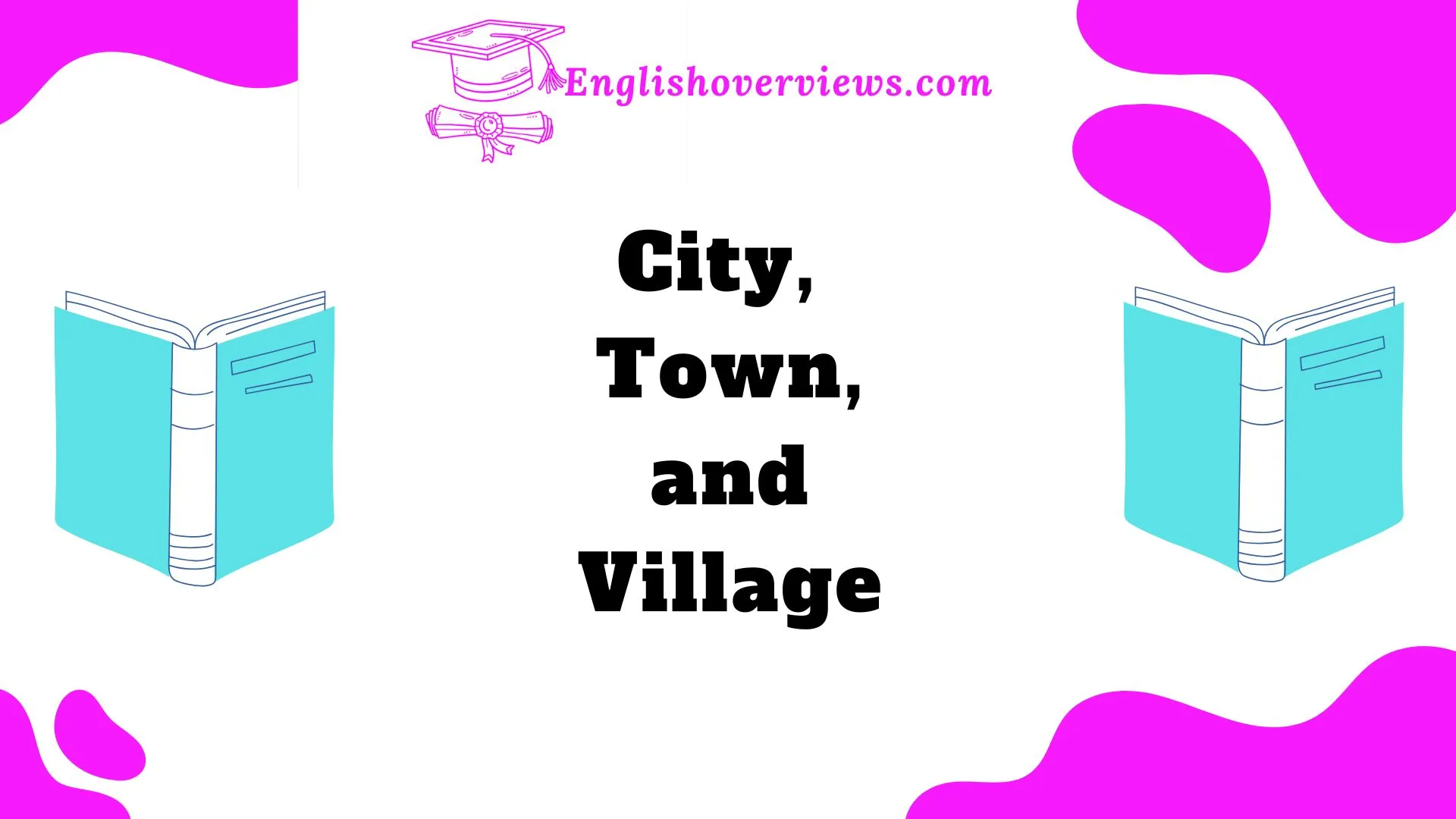Have you ever wondered why some people thrive in bustling cities while others prefer the charm of small-town life or the tranquility of a village? The differences between cities, towns, and villages go far beyond just population numbers.
They shape how we live, work, and connect with others. These distinctions influence the amenities available, the pace of life, and even our sense of identity.
This comprehensive guide dives deep into the defining features of cities, towns, and villages, exploring how they differ in lifestyle, governance, demographics, and more.
By the end, you’ll have a clearer understanding of which environment suits your needs and why these settlements play such unique roles in human history and society.
Defining the Terms: City, Town, and Village
What is a Village?
A village is the smallest type of settlement, characterized by its rural setting, smaller population, and simpler lifestyle. Villages are typically agricultural hubs or close-knit communities where traditions remain strong.
Key Characteristics of Villages:
- Population: Usually fewer than 1,000 people.
- Economy: Agriculture, fishing, or local crafts are the main economic activities.
- Infrastructure: Basic amenities like a primary school, small clinic, and local shops.
- Social Life: Strong community bonds, with everyone knowing everyone else.
Example:
The picturesque village of Hallstatt in Austria is known for its serene lakeside views and centuries-old traditions. Despite its small size, it has become a UNESCO World Heritage Site, drawing visitors worldwide.
What is a Town?
A town serves as a middle ground between a village and a city. It’s larger and more developed than a village, with better infrastructure and more opportunities, but it retains a sense of familiarity.
Key Characteristics of Towns:
- Population: Between 1,000 and 100,000 people.
- Economy: A mix of local businesses, small industries, and trade.
- Infrastructure: Towns often have high schools, hospitals, shopping centers, and recreational facilities.
- Social Life: More diverse than villages, but still with a sense of local identity.
Example:
The town of Asheville, North Carolina, blends a small-town feel with cultural vibrancy. It’s known for its thriving arts scene, historic architecture, and proximity to the Blue Ridge Mountains.
What is a City?
A city is a large, densely populated area that serves as a hub for business, culture, education, and government. Cities are often cosmopolitan and diverse, offering advanced amenities and endless opportunities.
Key Characteristics of Cities:
- Population: Typically over 100,000 residents.
- Economy: Diverse industries ranging from finance and technology to manufacturing and entertainment.
- Infrastructure: Cities boast extensive public transportation, universities, specialized hospitals, and cultural institutions.
- Social Life: Highly dynamic and diverse, with people from all walks of life.
Example:
Tokyo, Japan, is one of the world’s largest cities, with a population of over 37 million in the greater metropolitan area. It’s a global hub for innovation, technology, and culture.
Lifestyle Differences Across Settlements
Village Life: Close to Nature and Community
Villages are synonymous with simplicity, offering a slower pace of life and a deeper connection to nature.
Benefits of Village Life:
- Peaceful Environment: Far from the noise and chaos of cities.
- Tight-Knit Communities: Villages thrive on strong social ties, where neighbors often feel like family.
- Lower Cost of Living: Housing and essentials are generally more affordable.
Challenges of Village Life:
- Limited Amenities: Access to healthcare, education, and entertainment can be sparse.
- Employment Opportunities: Jobs are typically centered around agriculture or small-scale trades.
Real-World Case Study:
In Ubud, Bali, the local community relies heavily on rice farming and tourism. Despite limited resources, their sense of community and connection to nature makes it one of the most serene villages in the world.
Town Life: A Blend of Urban and Rural Living
Towns offer a balance between the calm of villages and the convenience of cities.
Benefits of Town Life:
- Moderate Pace: Life isn’t as fast as in cities but more dynamic than villages.
- Better Amenities: Towns often have hospitals, schools, and local businesses.
- Sense of Belonging: While larger than villages, towns still retain a sense of community.
Challenges of Town Life:
- Fewer Opportunities: Towns may lack the economic diversity of cities.
- Transport Limitations: Public transportation is often less developed.
Example:
The town of Taos, New Mexico, combines a vibrant arts community with small-town charm. Its historic adobe buildings and proximity to outdoor activities attract both locals and tourists.
City Life: Fast-Paced and Full of Opportunity
Cities are magnets for those seeking career growth, cultural diversity, and endless entertainment.
Benefits of City Life:
- Diverse Opportunities: Cities are hubs for careers in business, tech, entertainment, and more.
- Advanced Infrastructure: From public transit to world-class healthcare, cities offer unparalleled access.
- Cultural Diversity: Cities are melting pots of traditions, cuisines, and languages.
Challenges of City Life:
- High Cost of Living: Rent, utilities, and daily expenses can be significantly higher.
- Overcrowding: Traffic congestion and crowded public spaces are common.
- Stress Levels: The fast-paced lifestyle can lead to burnout.
Quote:
“Cities have the capability of providing something for everybody, only because, and only when, they are created by everybody.” – Jane Jacobs
Historic Roots and Evolution
Villages: The Birthplace of Civilization
Villages date back to the dawn of agriculture, around 10,000 years ago. Early humans formed villages near water sources and fertile land.
Towns: Centers of Trade
During the medieval period, towns emerged as trade hubs. They were strategically located near rivers, crossroads, or ports, fostering economic growth.
Cities: Engines of Innovation
Cities grew rapidly during the Industrial Revolution, with factories, railroads, and urban planning reshaping landscapes. Today, cities like Singapore lead the way in smart technology and sustainability.
Governance and Administrative Differences
| Governance Aspect | Village | Town | City |
| Local Authority | Village councils | Municipal councils | City governments |
| Decision-Making | Community-driven | Regional oversight | Bureaucratic |
| Services Provided | Basic (e.g., clean water) | Moderate (e.g., schools) | Comprehensive (e.g., transit systems) |
Key Fact:
City governments often handle challenges like urban planning and public transportation, while village councils focus on basic needs like irrigation or local roads.
Demographic and Cultural Characteristics
Villages:
- Homogeneous Communities: Shared traditions and customs.
- Stable Demographics: Minimal migration keeps populations consistent.
Towns:
- Evolving Identity: Trade and tourism diversify the population.
Cities:
- Cultural Melting Pots: Diverse languages, religions, and cuisines.
- Dynamic Growth: Constant migration leads to rapid change.
Amenities and Quality of Life
Comparison Table: Key Differences in Amenities
| Feature | Village | Town | City |
| Healthcare | Basic clinics | Small hospitals | Specialized care |
| Transportation | Rare | Moderate | Extensive |
| Entertainment Options | Minimal | Local events | Wide variety |
The Future of Villages, Towns, and Cities
Urbanization is reshaping all three settlement types. Villages are adapting with eco-tourism, towns are becoming commuter hubs, and cities are pioneering smart technologies. Initiatives like smart villages in India and green cities worldwide show that innovation isn’t limited to urban areas.
FAQs
1. What’s the biggest difference between a village and a city?
Villages have a small population and simpler lifestyles, while cities are large, diverse, and offer advanced amenities.
2. Why are towns important?
Towns act as bridges between rural and urban life, balancing convenience with a slower pace.
3. Can a village grow into a city?
Yes, with economic development and population growth, villages can evolve into towns and eventually cities.

English Overviews is a resourceful website dedicated to providing valuable content related to grammar and vocabulary. AD has made notable contributions, sharing insights on various subjects, including WordPress themes and plugins. The primary goal of the site is to help users improve their English language skills effectively.











